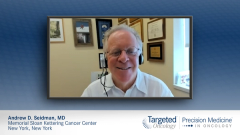
Challenges Managing CIN
Limitations of current therapies available for the prevention and management of chemotherapy-induced neutropenia.
Episodes in this series

Joyce O’Shaughnessy, MD: I just wanted to say a couple of other things about the limitations of our current regimens. You’ve already mentioned quite a bit, Andy. But I also wanted to mention, we’ve focused on this severe neutropenia, this ANC [absolute neutrophil count] less than 100 [per μL], which I think strikes fear into all of us. A limitation, as you know Andy, is when the patients get the chemotherapy day 1, and then they basically end up getting the injection of the pegfilgrastim day 2, whether it’s on body, or whether it’s day 2 subq [subcutaneous]. We don’t get the effects for the first week. So patients [reach a] nadir, and then they recover. But a week later, I tell all the patients, “That’s your vulnerable period, here. That’s when you’ve got to be particularly vigilant; expect to feel your worst. You’ve got to call us if you start getting mouth sores and diarrhea. That’s the last thing you need, at that particular time.” In fact, Andy, when I get a vulnerable patient who, let’s say for example, has had a history of diverticulitis, I always ask, “Have you had diverticulitis in the past?” If so, I cover them from day 5 to 10 with a prophylactic antibiotic. I use levofloxacin. That is vulnerable, and I can’t count on the pegfilgrastim to be there. What do they call that? The neutrophil vulnerability gap, is that what it is?
Andrew D. Seidman, MD: Yes, NVG. I think that’s a good a term as any, the neutrophil vulnerability gap. Before pegfilgrastim starts to kick in, there is this period of time where, after chemotherapy, your neutrophil count can drop into that profound range. I don’t consistently use antibiotics prophylactically, but on occasion I don’t want to send my patient, who’s driven into Manhattan and paid $50 to park her car, home when her ANC is 900 or 1000 [per μL]. I worry about those patients, particularly, even when they leave with pegfilgrastim as part of the treatment plan. I’d rather treat that patient whose ANC is on the cusp of my parameter, if you will. Sometimes that’s a mistake. Sometimes those are the patients who are calling the office on day 4 or day 5. And I kick myself, because I say, “Well, if I [had only been] more patient, I could’ve told [my] patient to drive home to New Jersey and come back next week.”
Joyce O’Shaughnessy, MD: You raise a really important point there. We all see it. Our patients rearrange their whole lives. They get childcare. They take a day off from work. Somebody has to cover for them; work is a big deal. And then we tell them they can’t get treated. If we had something that could help them through that first week—that’s this new agent, plinabulin, which we’ll talk about here in a second. If we could address that time period that you’re worried about, that would really help our patients a great deal to be able to function in their lives at a higher level. Of course, [there are] the health care costs, economic costs in general of lost productivity, etc. But you’re right, that’s a lot of pressure, if somebody paid $50 for parking. Gosh, never mind the traffic into Manhattan. That’s a lot of pressure on the oncologist to determine, “Can I go ahead and treat this patient?” That’s certainly one big limitation that we have, the vulnerable first 7 to 8, perhaps 9 days for our patients, particularly if they have comorbidities. Another limitation that I see all the time, Andy, I’m sure you do too because of the amount of dose-dense [therapy] you guys use, is that when you use the pegfilgrastim every 2 weeks, the cumulative anemia is substantial. It’s kind of like the marrow is not quite ready yet to have that next dose of pegfilgrastim coming at it, at the 2-week mark. You can also get the cumulative thrombocytopenia there, as well. The neutrophils are doing fine because they get the pegfilgrastim. But I see that all the time; it’s really quite a limitation. Sometimes patients either need transfusions, or they get so tired by the time they have finished. You’re holding on, and you know they’ve got to go to surgery too, before too long. So that’s an issue. I kind of call it the “burning marrow thing,” where the marrow is so revved up, and here comes the next chemotherapy on top of it. If you give it every 3 weeks, you don’t get that. You don’t get that as much. Do you see that a lot, Andy?
Andrew D. Seidman, MD: Yes. I always tell patients, AC [doxorubicin and cyclophosphamide] 3 and 4 are going to be the hardest part of the treatment with sequential dose-dense AC, taxane therapy. I think transfusion is probably not that common. But we don’t use erythroid growth factors in breast cancer anymore. At least I don’t think we do.
Joyce O’Shaughnessy, MD: No, I don’t. No.
Andrew D. Seidman, MD: So, there’s another unmet need.
Transcript edited for clarity.













































